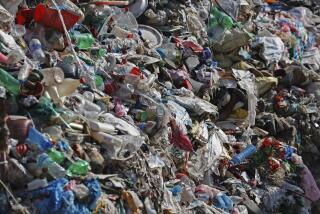Artist in Maine transforms Mt. Everest trash into treasures
- Share via
BRUNSWICK, MAINE — Thousands of adventurers have been drawn to Mt. Everest by the challenge of climbing to the top of the world. Jeff Clapp was drawn by the trash they leave behind.
Inspired by a documentary about Everest’s rubbish, Clapp traveled to Nepal and brought a load of discarded oxygen bottles back in 2004.
He has created a business of transforming those banged-up aluminum containers into gleaming bells, bowls and ornaments with a goal of inspiring people to do more to clean up the environment in their own small ways, just as he has.
“One guy can make a difference,” he said, whether by transforming trash into treasures, turning off lights, installing insulation or using less gas. What began as a “madcap idea” is now called Bells From Everest. Clapp has sold 35 bells and bowls so far.
The trashing of Everest began even before Sir Edmund Hillary and Sherpa Tenzing Norgay first scaled the world’s tallest mountain in 1953. Hillary acknowledged leaving behind oxygen bottles, food containers and torn tents near his base camp.
Virtually all hikers rely on oxygen because the air at Everest’s summit has one-third of the oxygen found at sea level. Over the years, hundreds of bottles piled up along with discarded climbing gear and other trash.
Efforts to clean up the 29,035-foot mountain include a successful bounty program for oxygen bottles left behind. The Nepalese government now requires expeditions to pay deposits that are forfeited if rubbish is left.
Clapp was inspired to go to Nepal by a National Geographic documentary about trash on Everest. He obtained 132 cylinders from the Nepal Mountaineering Assn. for $7,000. It cost nearly that much to ship them back to Maine. Back at home in Brunswick, he works on the canisters in a basement workshop.
The hardest part, he said, is stripping away the yellow fiberglass shell to expose the darkened, oxidized aluminum underneath. He then uses hand tools to shape the bottles as they spin on a wood-turning lathe.
Eventually, they’re buffed to a shiny silver color. Prices range from $1,600 to $3,000 for bells, and $500 to $1,500 for the bowls.
Clapp, 48, said buyers liked getting an unusual artwork and knowing that they were helping the environment.
When his supply of oxygen cylinders runs out in a few years, Clapp doesn’t plan to retrieve more. But he would like to return to Nepal to show locals how to create the bells to make money for themselves. Clapp said he hoped to line up corporate sponsors for the project and to create a documentary. Eventually, he wants to write a book.
“My ultimate goal of returning this project to Nepal is very exciting to me,” he said. “When I first visualized creating this artwork, I was driven with the concept that it would be a benefit to others, specifically in Nepal.”
More to Read
Sign up for The Wild
We’ll help you find the best places to hike, bike and run, as well as the perfect silent spots for meditation and yoga.
You may occasionally receive promotional content from the Los Angeles Times.






